
Sights set on pasture dieback
Queensland producer Will Wilson didn’t know dieback was present on his Biloela property until he went looking for it. Here, he shares his tips for managing dieback and minimising risk.
The red meat and livestock industry is working in close collaboration to respond to the on-farm challenges presented by pasture dieback. MLA, Queensland Department of Agriculture and Fisheries and NSW Department of Primary Industries are working alongside red meat producers, research institutions, peak industry councils and state farming organisations to ensure ongoing investment in pasture dieback research is effective, well-coordinated and clearly communicated.
Pasture dieback: a management guide for producers and agronomists brings together the latest information on causal factors and management strategies associated with pasture dieback.
Pasture dieback is a condition which causes the death of sown and native pastures by affecting plant health and function, reducing the productivity of affected properties. It has been observed in a range of soil types and plant species across Queensland and northern NSW.
The condition occurs episodically, with the current outbreak first identified in early 2015 and spreading across eastern Queensland in subsequent years. In early 2020, pasture dieback was also confirmed in northern NSW.
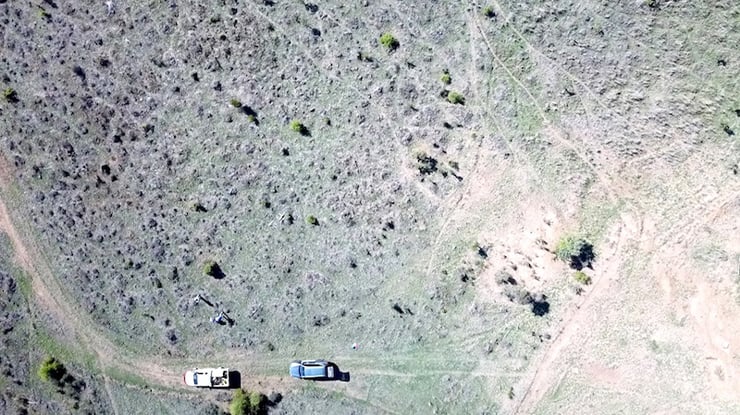
A pasture dieback-affected paddock of buffel grass in Barallabra, Queensland
The symptoms of pasture dieback generally occur initially as patches in otherwise seemingly healthy pastures. If a producer suspects pasture dieback on their property, they should be on the look-out for:
Initially, patches of dieback are roughly circular, ranging from 2–60m in diameter. These areas can grow irregularly, spreading at speeds ranging from slow (cm2/week in the dryer, colder months) to rapid (ha/week in the wetter, warmer months). Multiple patches can coalesce to form large, dead areas.
Producers have also observed that dieback is most severe in areas of long grass with large amounts of thatching – for example, under fence lines or areas of low pasture utilisation.
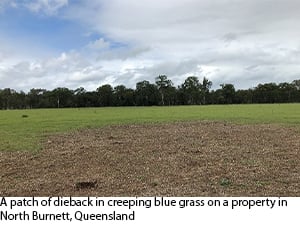
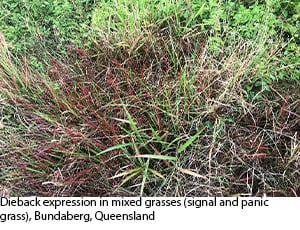
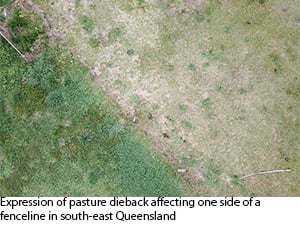
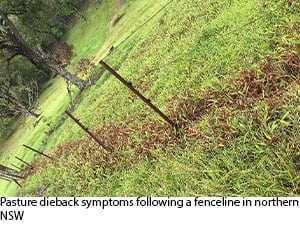
Reliable estimates of pasture affected by dieback are currently not available, however, AgForce has predicted the outbreak to cover a large area of productive Queensland, with estimates ranging between 400,000 and 4.4 million hectares.
The below map shows the approximate areas pasture dieback has been reported in. However, it does not indicate how prevalent pasture dieback is in each region, as this information is currently not available.

The main species which have been affected in Queensland are:
Source: QDAF
The main species which have been affected in northern NSW are:
* denotes pastures which have only shown symptoms, and not pasture death.
Source: NSW DPI
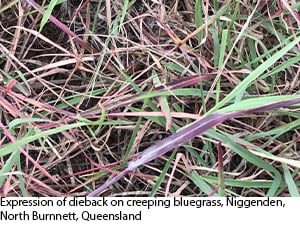
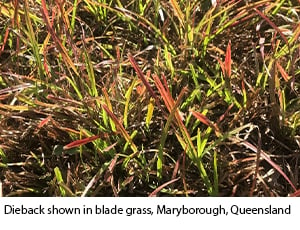
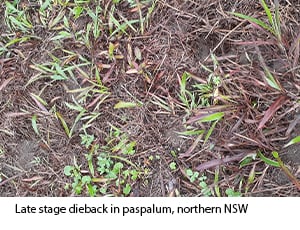
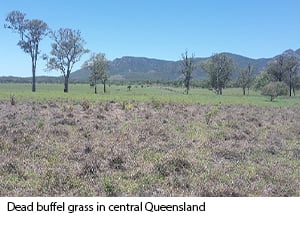
A. Although it is not definitive, there are strong indications that pasture mealybugs (Heliococcus summervillei) are the leading cause of dieback. However, research also indicates there are secondary causal factors at play, and understanding these is key to understanding why episodic outbreaks occur.
A. Currently there are no APVMA approved and registered chemicals which can be used to treat pasture dieback.
A. Patches of dieback are initially roughly circular, ranging from 2–60m in diameter. These areas can grow irregularly, spreading at speeds ranging from slow (cm2/week in the dryer, colder months) to rapid (ha/week in the wetter, warmer months). Multiple patches can coalesce to form large, dead areas.
A. Yes. As a generalised name, dieback can affect a range of plants and as a disease is identified when large areas of plants die without an obvious cause. Dieback has been reported in plants including eucalypts, salt marshes, woody weeds, orchard trees and turf grass.
The cause of dieback across different plants is not consistent, however, examples from other types of dieback may provide guidance for research into pasture dieback.
MLA is working with industry bodies, state departments and researchers across affected regions to ensure a coordinated approach to investment in research, development, extension and adoption is being taken to support producers in combatting dieback.
|
MLA’s objective is to ensure pasture dieback research and development is focused on finding solutions for those affected by it and to provide valuable, up-to-date information to producers as it comes to hand. A key focus is supporting the delivery of short-term solutions to feed livestock while a permanent solution to pasture dieback is investigated. |
The Queensland Department of Agriculture and Fisheries and NSW Department of Primary Industries have key roles within their state jurisdictions to undertake measures to control the outbreak of pasture dieback. Through its industry-focused response, MLA is supporting these organisations to do so.
In mid-2019, the Department of Agriculture, Water and the Environment awarded a $2.7 million grant to MLA to undertake research and development activities to further understand pasture dieback, with a focus on determining the role of mealybugs in the presence of dieback-affected pastures. MLA has committed to matching this grant with producer levy investment to ensure solutions-focused research, development and adoption activities are undertaken to support the industry.
MLA’s plan on a page summarises the federal grant work plan and MLA’s direction in its response to pasture dieback.
A central component of investment so far has centred around understanding mealybugs as the leading causal agent of dieback. However, MLA’s understanding is that there are other secondary factors which contribute to the episodic outbreaks of dieback that occur. Some of the new projects are focused on understanding these factors to better tailor solutions while investigations into the mealybug continue.
Research partners:
MLA's pasture dieback governance
Past work conducted on pasture dieback:
Current projects:*
* Project partners work together across affected sites and collaboration occurs when work overlaps and interlinks. MLA’s role is to facilitate this collaboration. Protocols will be matched across projects for consistent results.
Read this article for new insights to tackle pasture dieback
Queensland producer Will Wilson didn’t know dieback was present on his Biloela property until he went looking for it. Here, he shares his tips for managing dieback and minimising risk.
When pasture dieback devastated 70% of one of their Central Queensland properties, beef producers Greg and Vicki Lawrence turned to legumes to help fill the gap in their feedbase – in this case study, Greg shares how they’ve even tapped into production benefits along the way.
If you’re concerned about pasture dieback, please call the DAF Customer information centre on 13 25 23, or visit your local DAF office and talk to a DAF Beef extension officer.
If you suspect symptoms of pasture dieback:

